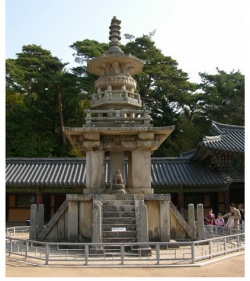Bulguksa dabotap
Dabotap Pagoda and Seokgatap Pagoda (Sakyamuni pagoda) (Bulguksa Temple's three-story stone pagoda, National Treasure No. 21) are the two representative pagodas in Korea.
The height of the two is the same of 10.4m.
The two pagodas stand facing each other at the yard, one in the east and the other in the west, between Hall of Sakyamuni and Jahamun Gate in Bulguksa Temple.
The one in the east is Dabotap Pagoda.
This pagoda is a representative special-type pagoda, and Seokgatap Pagoda (Sakyamuni pagoda) a representative general-type stone pagoda.
The reason of building the two pagodas at the same site is to follow the content of Beophwagyeong (the Lotus Sutra) that the 'past Buddha' Dabo Buddha is standing beside the 'present Buddha Sakyamuni to prove that his Buddhist sermon is right.
Bulguksa Temple was founded by Kim Daeseong's offer in the 10th year (751) of King Gyeongdeok in Silla Period.
Samgukyusa ("History of the Three Kingdoms") says that Kim Daeseong built Seokguram Temple for his parents in his former life and Bulguksa Temple for his present parents.
However, the construction of this temple was not finished till he died, and so it was finished afterwards by the Kingdom. After all, the temple was built not for the individual Kim Daeseong but for the Kingdom.
Bulguksa Temple can be said to be the materialized Buddhist Elysium, or paradise where the past, present, and future Buddhist monks live. It shows the spirit world of the people in Silla Period very well.
We can easily see that Seokgatap Pagoda (Sakyamuni pagoda) is a 3-story pagoda standing on 2-story platform. But It is difficult to count the number of stories in Dabotap Pagoda.
In fact, even experts have confusing opinions, some saying it is 4-story, others saying it is 3-story.
However, the uniqueness of Dabotap Pagoda can be found at the structure of each part.
In the whole figure, 2-story rooms as pagoda body stand on the platform, and head decorations are on the top. The planes are cut to be square at the platform, and octagonal at the parts above it.
Uniquely, it seems that there were stone staircases with guardrails on the four direction of the platform. But only stone pillars are left on both sides presently.
They built the octagonal pagoda body after surrounding square guardrails around it.
And they carved octagonal guardrails, bamboo joint-shaped stone pillars, and sixteen pieces of lotus flower design on the pagoda body.
The skill is so excellent that we can't imagine they carved from stones.
The head decoration of Seokgatap Pagoda (Sakyamuni pagoda) is a restored one, while that of Dabotap Pagoda almost perfectly remains as it used to be.
This work is a masterpiece that excellently expresses the complicated structure of wooden construction without distraction through novel ideas.
The work evidently shows the artistic essence of the United Silla Kingdom in that it has the well-organized structure using squares, octagons, and circles, and in that the length, width and thickness are standardized in every part.
The pagoda seems to have been built in 751 when Bulguksa Temple was freshly remodeled with a large scale.
It is unfortunate that Dabotap Pagoda entirely contains the sorrow that the people felt when the Japanese Empire deprived them of the country.
The Japanese dismantled and repaired the pagoda around 1925, but they didn't leave any record about this fact. In the process, sarira, sarira casket and other relics that must have been put into the pagoda all disappeared.
And out of four lions that were on the stone staircases of the pagoda, the Japanese Empire robbed us of three lions that must have been in good condition.
Though we have long made efforts to retrieve the precious cultural properties, we can't find their trace yet.
